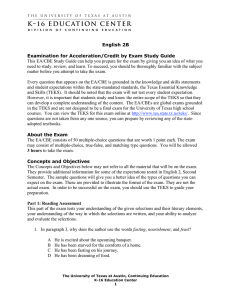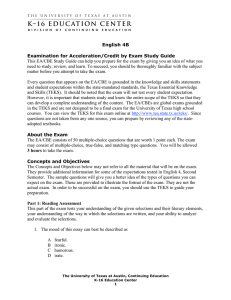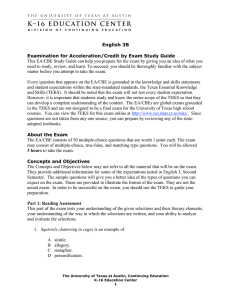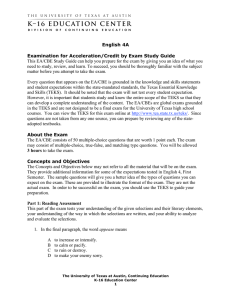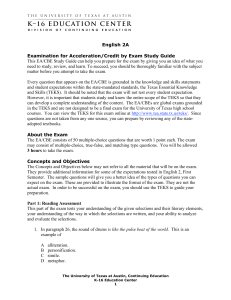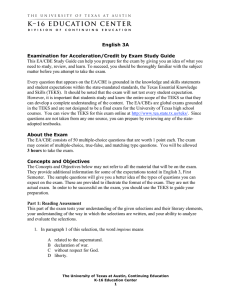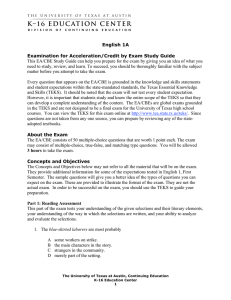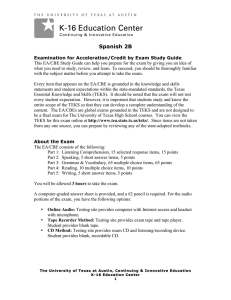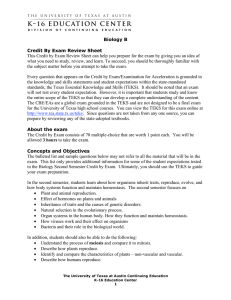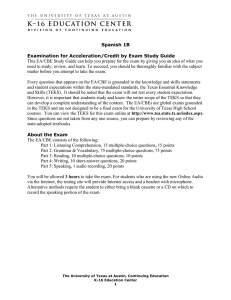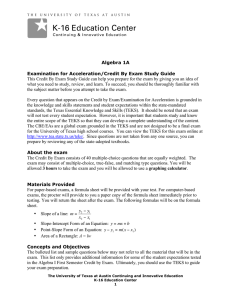This EA/CBE Study Guide can help you prepare for the... need to study, review, and learn. To succeed, you should... English 1B
advertisement
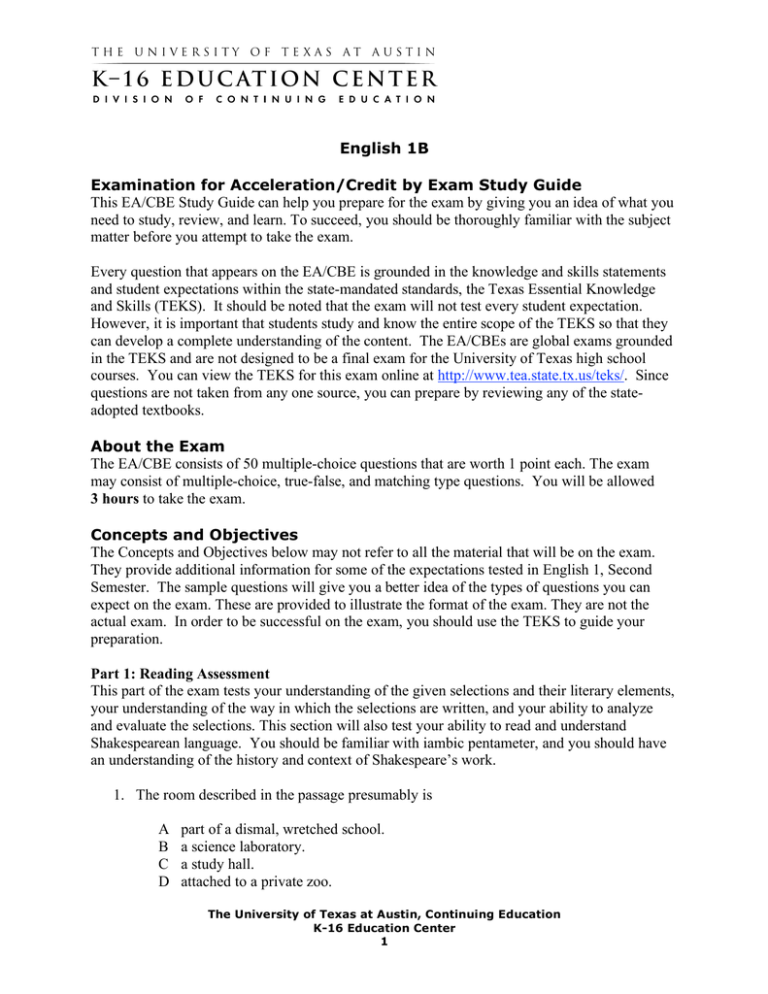
English 1B Examination for Acceleration/Credit by Exam Study Guide This EA/CBE Study Guide can help you prepare for the exam by giving you an idea of what you need to study, review, and learn. To succeed, you should be thoroughly familiar with the subject matter before you attempt to take the exam. Every question that appears on the EA/CBE is grounded in the knowledge and skills statements and student expectations within the state-mandated standards, the Texas Essential Knowledge and Skills (TEKS). It should be noted that the exam will not test every student expectation. However, it is important that students study and know the entire scope of the TEKS so that they can develop a complete understanding of the content. The EA/CBEs are global exams grounded in the TEKS and are not designed to be a final exam for the University of Texas high school courses. You can view the TEKS for this exam online at http://www.tea.state.tx.us/teks/. Since questions are not taken from any one source, you can prepare by reviewing any of the stateadopted textbooks. About the Exam The EA/CBE consists of 50 multiple-choice questions that are worth 1 point each. The exam may consist of multiple-choice, true-false, and matching type questions. You will be allowed 3 hours to take the exam. Concepts and Objectives The Concepts and Objectives below may not refer to all the material that will be on the exam. They provide additional information for some of the expectations tested in English 1, Second Semester. The sample questions will give you a better idea of the types of questions you can expect on the exam. These are provided to illustrate the format of the exam. They are not the actual exam. In order to be successful on the exam, you should use the TEKS to guide your preparation. Part 1: Reading Assessment This part of the exam tests your understanding of the given selections and their literary elements, your understanding of the way in which the selections are written, and your ability to analyze and evaluate the selections. This section will also test your ability to read and understand Shakespearean language. You should be familiar with iambic pentameter, and you should have an understanding of the history and context of Shakespeare’s work. 1. The room described in the passage presumably is A B C D part of a dismal, wretched school. a science laboratory. a study hall. attached to a private zoo. The University of Texas at Austin, Continuing Education K-16 Education Center 1 ENG 1B 08410 EA/CBE Study Guide Part 2: Elements of Drama This part of the exam tests your knowledge and understanding of drama elements. You will be expected to know about the elements of both conventional drama and Shakespearean drama. You should also be familiar with conflict, dialogue, character, and figurative language. 2. The part of the play that develops the conflict is the A B C D exposition. rising action. climax. falling action. Part 3: Vocabulary Strategies—Analogies This part of the exam tests your understanding and application of vocabulary techniques and relationships between words. You will think about the different relationships that can be expressed in analogies, such as cause and effect, size, shape, or time, and then determine the relationship between the pairs of words given. 3. reduce : reduction :: A B C D sit : sat edition : edit illustrate : illustration lie : lay Part 4: Media Literacy This part of the exam tests your ability to analyze and critically evaluate texts and visual representations used in media. You will be asked to analyze a provided advertisement. 4. The purpose of studying media literacy is to A B C D be able to use technology and scientific method to make purchases. know when you are getting a good deal on a product. locate reliable sources of information. develop an ability to interpret and evaluate advertising claims. The University of Texas at Austin, Continuing Education K-16 Education Center 2 ENG 1B 08410 EA/CBE Study Guide Part 5: Poetic Elements This part of the exam tests your understanding of poetry, the literary elements within the selection, and your ability to analyze and evaluate the selection. You should understand the literal as well as the figurative language of poetry and the poetic techniques used to achieve the author’s purpose. 5. In this poem, the speaker is A B C D unable to express emotions. someone who does not make friends easily. a person who cannot forgive and forget. someone who enjoys evil. Part 6: Figurative Language This part of the exam tests your understanding of figurative language. You will be expected to identify and understand the use of figurative language in written works. 6. “The blue sky glittered like a new-honed knife.” A B C D Repetition Personification Simile Metaphor Part 7: Literary Analysis This part of the exam tests your ability to evaluate and analyze different types of literature and the literary elements typically assigned at this level. You should read The Tragedy of Romeo and Juliet by William Shakespeare, “Song of the Open Road” by Walt Whitman, and “Lineage” by Margaret Walker in order to be successful on this part of the exam. 7. What does the following line from “Lineage” tell you about the speaker’s grandmothers? They touched earth and grain grew A B C D They found their work effortless. They knew how to use magic. They used modern equipment and methods. They were good at their work. The University of Texas at Austin, Continuing Education K-16 Education Center 3 ENG 1B 08410 EA/CBE Study Guide Part 8: Writing Assessment This part of the exam tests your understanding of the purpose of written expression and the structural make-up of a literary analysis. You will be given part of an essay written on a particular reading selection. You will be asked to identify parts of an essay and writing techniques used in well-organized writings. 8. In addition to his noble birth, Romeo is often impetuous. A B C D Example to support the thesis statement Topic Sentence Summary of plot Transitional sentence Answer Key NUMBER 1 2 3 4 5 6 7 8 CORRECT ANSWER A A C D C C A D TEKS 11C, 11E 11D, 11E, 11H 6B, 6F, 9B 7A, 8B, 12C, 19A, 20B 7B, 7C, 7H, 9B 7B, 7E, 9B, 11H 7B, 7E, 7G, 9B, 10B, 11C 1A, 1C, 3C, 12C The University of Texas at Austin, Continuing Education K-16 Education Center 4
